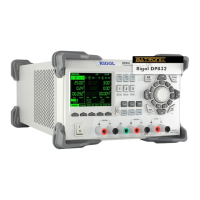RIGOL Chapter 2 Front Panel Operations
2-12 DP800 User’s Guide
Stair Dn
The Stair Dn waveform is as shown in the figure below. The instrument
determines the Stair Dn waveform according to the maximum (denoted by
MAX), minimum (denoted by MIN), total number of points (denoted by P)
and time interval currently set and creates P parameters from MIN to MAX
at the step of (MAX-MIN)/(P-1). The timing time is determined by the
time interval currently set.
Stair Dn
StairUpDn
The StairUpDn waveform is as shown in the figure below. The instrument
determines the StairUpDn waveform according to the maximum (denoted
by MAX), minimum (denoted by MIN), total number of points (denoted by
P) and time interval currently set and creates P parameters. When P is an
odd number, the value increase from MIN to MAX at the step of
(MAX-MIN)/int(P/2)
[1]
and then reduces to MIN at the same step.
When P is an even number, the value increases from MIN to MAX at the
step of (MAX-MIN)/int(P/2-1) and then reduces to MIN at the step of
(MAX-MIN)/int(P/2). The timing time is determined by the time interval
currently set.
StairUpDn
Note
[1]
: int(P/2) indicates rounding P/2.
Exp Rise
The Exp Rise waveform is as shown in the figure below. The instrument
determines the Exp Rise waveform according to the maximum (denoted by
MAX), minimum (denoted by MIN), total number of points (denoted by P)
and rise index (denoted by RiseIndex) currently set. The waveform
function is (MAX-MIN)*[1-e
-i*RiseIndex/P
]; wherein, i is independent
variable and creates P groups of parameters from 0 to (P-1). The timing
time is determined by the time interval currently set.

